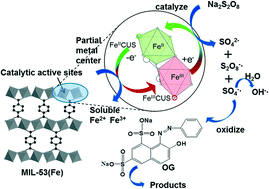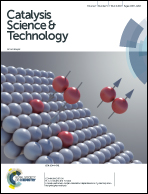Activation performance and mechanism of a novel heterogeneous persulfate catalyst: metal–organic framework MIL-53(Fe) with FeII/FeIII mixed-valence coordinatively unsaturated iron center†
Abstract
In this work, a novel and effective heterogeneous catalyst, the metal–organic framework MIL-53(Fe), has been synthesized for the purpose of activating persulfate (PS). The catalytic performance of MIL-53(Fe) activated under different vacuum conditions was investigated; the stability and reusability of the catalyst were evaluated, and the activation mechanism was also investigated. The results indicated that vacuum activation could cause variation of the FeII/FeIII relative amount ratio of the catalyst, and thus would change the catalytic activity of MIL-53(Fe), because FeII and FeIII CUS (coordinatively unsaturated metal sites) are alternative active sites. It was found that MIL-53(Fe)-2 exhibits good performance in PS activation and could be used for multiple cycles; an OG removal rate of 98% was obtained within 120 min (95.7% mineralization efficiency) and 94.3% was achieved in the fifth cycle. The mechanism of activation of PS by MIL-53(Fe) was also suggested, which involved a predominant heterogeneous reaction and an auxiliary homogeneous reaction. The findings of this study provide a new insight into the application of reactive metal–organic frameworks in activating persulfate for the degradation of environmental contaminants.

- This article is part of the themed collection: 2017 Catalysis Science & Technology HOT Articles


 Please wait while we load your content...
Please wait while we load your content...